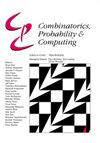晶格色的混合性质
IF 0.8
4区 数学
Q3 COMPUTER SCIENCE, THEORY & METHODS
引用次数: 3
摘要
我们研究并分类了lgd格的固有q-着色,确定了具有不同组合行为的三种区域。(1)当$q\le d+1$时,存在冻结着色,即存在不能在任意有限子集上被修改的适q-着色。(2)证明了一个强表着色性质,该性质表明,当$q\ge d+2$时,边长为$n \ge d+2$的盒子的边界的任何适当q-着色都可以推广为整个盒子的适当q-着色。(3)当$q\geq 2d+1$时,后者适用于任何$n \ge 1$。因此,我们根据它们的混合性质对素格的固有q色空间进行了分类。本文章由计算机程序翻译,如有差异,请以英文原文为准。
Mixing properties of colourings of the ℤd lattice
We study and classify proper q-colourings of the ℤd lattice, identifying three regimes where different combinatorial behaviour holds. (1) When
$q\le d+1$
, there exist frozen colourings, that is, proper q-colourings of ℤd which cannot be modified on any finite subset. (2) We prove a strong list-colouring property which implies that, when
$q\ge d+2$
, any proper q-colouring of the boundary of a box of side length
$n \ge d+2$
can be extended to a proper q-colouring of the entire box. (3) When
$q\geq 2d+1$
, the latter holds for any
$n \ge 1$
. Consequently, we classify the space of proper q-colourings of the ℤd lattice by their mixing properties.
求助全文
通过发布文献求助,成功后即可免费获取论文全文。
去求助
来源期刊

Combinatorics, Probability & Computing
数学-计算机:理论方法
CiteScore
2.40
自引率
11.10%
发文量
33
审稿时长
6-12 weeks
期刊介绍:
Published bimonthly, Combinatorics, Probability & Computing is devoted to the three areas of combinatorics, probability theory and theoretical computer science. Topics covered include classical and algebraic graph theory, extremal set theory, matroid theory, probabilistic methods and random combinatorial structures; combinatorial probability and limit theorems for random combinatorial structures; the theory of algorithms (including complexity theory), randomised algorithms, probabilistic analysis of algorithms, computational learning theory and optimisation.
 求助内容:
求助内容: 应助结果提醒方式:
应助结果提醒方式:


